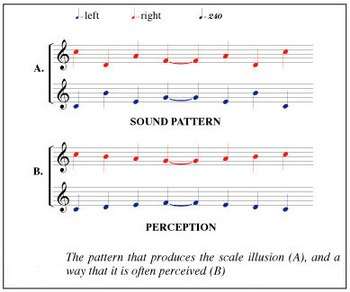Deutsch's scale illusion
Discovered by Diana Deutsch in 1973, Deutsch's "scale illusion" is an auditory illusion in which principles of grouping by frequency, proximity, and spatial location are put into conflict and in which frequency proximity wins out.[1] It is produced by simultaneous ascending and descending major scales beginning in separate stereo channels with each successive note being switched to the opposite channel. With the left channel: C'-D-A-F--A-D-C'; and the right: C-B-E-G-E-B-C; the ear hears both: C'-B-A-G--A-B-C'; and: C-D-E-F--E-D-C. The tones are equal-amplitude sine waves, and the sequence is played repeatedly without pause at a rate of four tones per second. (Listen to the Stereo Sound Example linked below.)

When listening to the illusion over headphones, most right-handers hear a melody corresponding to the higher tones as on the right and a melody corresponding to the lower tones as on the left. When the earphone positions are reversed, the higher tones continue to appear to be coming from the right and the lower tones from the left. Other people experience different illusions, such as the higher tones on the left and the lower tones on the right, or a pattern in which the sounds appear to be localized in different and changing ways. Right-handers and left-handers differ statistically in how the scale illusion is perceived.
In a clinical study, patients with hemispatial neglect were shown to experience the scale illusion. Further, in an MEG study on normal listeners the scale illusion was found to be neurally represented at or near the auditory cortex.
Further reading
- Deutsch, D. (1974). "An illusion with musical scales". Journal of the Acoustical Society of America. 56: s25. doi:10.1121/1.1914084. Abstract
- Deutsch, D. (1975). "Two-channel listening to musical scales". Journal of the Acoustical Society of America. 57 (5): 1156–1160. doi:10.1121/1.380573. PMID 1127169. Abstract PDF Document
- Deutsch, D. (1975). "Musical Illusions". Scientific American. 233 (4): 92–104. doi:10.1038/scientificamerican1075-92.
- Deutsch, D. (1979). "Binaural integration of melodic patterns". Perception & Psychophysics. 25 (5): 399–405. doi:10.3758/BF03199848. PMID 461100. PDF Document
- Deutsch, D. (1983). "Auditory illusions, handedness, and the spatial environment". Journal of the Audio Engineering Society. 31: 607–618.
- Deutsch, D. (1985). "Dichotic Listening to Melodic Patterns and Its Relationship to Hemispheric Specialization of Function". Music Perception. 3 (2): 127–154. doi:10.2307/40285329. JSTOR 40285329. S2CID 33980647. PDF Document
- Deutsch, D. (1987). "Illusions for Stereo Headphones". Audio Magazine: 36–48. PDF Document
- Radvansky GA, Hartmann WM, Rakerd B (1992). "Structural alterations of an ambiguous musical figure: the scale illusion revisited". Perception & Psychophysics. 52 (3): 256–62. doi:10.3758/bf03209143. PMID 1408637.
- Deutsch, D. (2013). Grouping mechanisms in music In D. Deutsch (Ed.). The Psychology of Music (3rd ed.). pp. 183–248. doi:10.1016/B978-0-12-381460-9.00006-7. ISBN 9780123814609. PDF Document
- Kuriki, S.; Yokosawa, K. & Takahashi, M. (2013). "Neural Representation of Scale Illusion: Magnetoencephalographic Study on the Auditory Illusion Induced by Distinctive Tone Sequences in the Two Ears". PLOS ONE. 8 (9): e75990. doi:10.1371/journal.pone.0075990. PMC 3781093. PMID 24086676. PDF Document
- Deouell, L. Y.; Deutsch, D.; Scabini, D.; Soroker, N. & Knight, R. T. (2008). "No disillusions in Auditory Extinction: Perceiving a Melody Comprised of Unperceived Notes". Frontiers in Human Neuroscience. 1: 15. doi:10.3389/neuro.09.015.2007. PMC 2525977. PMID 18958228. PDF Document
Sources
- Bregman, Albert (1994). Auditory Scene Analysis: The Perceptual Organization of Sound, p.76. ISBN 0-262-52195-4.